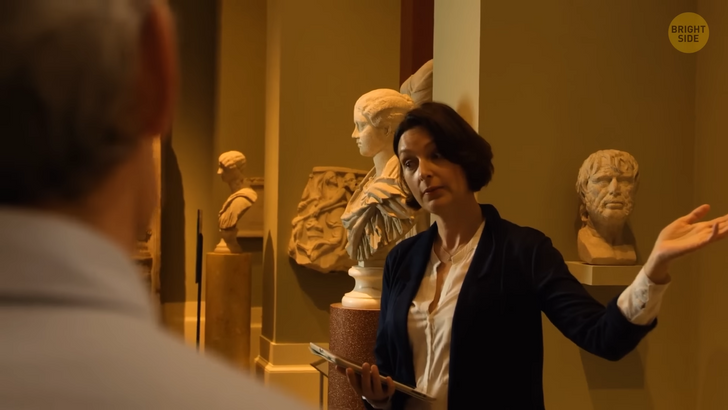10 Real Stories That Feel Like a Tightrope Walk

Ever been to a museum and realized that the public is just a few steps away from the valuable artworks and artifacts on display? I mean, sometimes it’s just a silly velvet rope, and other times, there’s nothing at all to keep people at bay. But, let’s imagine for a second that you’re walking by, minding your own business, and you accidentally trip and knock down a shelf filled with priceless Etruscan urns.
Not only would the urns obviously shatter into a million pieces, but what would happen to you? I mean, can you picture yourself standing there covered in broken ceramic, trying to play it cool like you didn’t just cause a major disaster? If it were me, I’d likely pull out my best Urkel impression and say “Did I do that?”

Anyway, now you don’t need to keep guessing what happens next. Thanks to a few brave souls who have embarrassed themselves in public, we finally have the answer. Back in 2010, there was this girl who was taking a class at the Metropolitan Museum of Art in New York City. While walking around, she tripped and fell right into a Picasso painting, which happened to be worth a staggering $130 million!
That’s not the worst part though, she accidentally punched a six-inch hole in the canvas with her hand. Luckily, the painting wasn’t ruined beyond repair. Even though it looked pretty bad at first glance, the rip was actually on the side of the artwork and didn’t do much harm to the main subject. They ended up fixing it over the course of three months, and you couldn’t even tell that there had been any damage at all!
When they put it back on display, they decided to play it safe and added an extra layer of protection in the form of plexiglass, just in case someone else accidentally bumps into it. As for the clumsy art enthusiast, the museum released a statement to assure everyone that she was okay. And then they let her go home without even charging her a penny for the repairs. Talk about getting off easy!
In fact, whenever art is damaged, it’s usually not as dramatic as you might think. The most severe punishment the guilty party will face is usually being banned from the museum, but even that’s pretty rare. Take for example the guy who tripped over his own laces and wiped out three priceless 17th-century vases at a museum in Cambridge. The museum just kindly asked him to take a break from visiting for a while.

Or there’s this elderly couple who decided to take the term “hands-on” to the extreme. These two lovebirds visited the National Watch and Clock Museum in Pennsylvania and got a bit too curious with the exhibits. In particular, they set their sights on a unique piece created by artist James Borden. Instead of just admiring it from afar, they decided to pull and tug on the clock’s moving parts, trying to see how it works.
Unfortunately, the clock had different ideas and ended up shattering on the floor. You’d think the museum would’ve gone into full-on attack mode, but instead, they gave the couple a break and didn’t press any charges. And even for reckless selfie-lovers, it’s quite hard to get in trouble for real.
In May 2016, there was a daring selfie enthusiast who wanted to take a photo with a 150-year-old statue of Portugal’s King Sebastian. But the problem was that the statue was on a pedestal, several feet off the ground. While most people would have taken a picture of the stone king in the background, our hero was determined to have a picture of himself right next to the monarch. So, he made a bold decision and climbed the front of the building where the statue was located.
Guess what happened after? “The statue ended up wrecked to pieces,” you say? Right you are. The unfortunate tourist got arrested and had to pay a fine for destroying the monument, which was a part of the city’s property. But in general, museums are more lenient towards visitors who damage their exhibits. This is because most items have an insurance policy covering them, and visitors are considered guests. So even if someone accidentally damages something, the museum will likely just take their contact information to fill out an insurance claim, and won’t hold them financially responsible.

Museum workers don’t suffer too much of a consequence for an honest mistake either. A group of porters in England learned it the hard way. They threw away a box, thinking it was empty, only to find out later that it actually contained an expensive painting — like, $120,000 expensive. Oops! To make matters worse, the box had already been fed into a crushing machine with a bunch of other garbage when the mistake was discovered.
In 2014, an Italian janitor mistakenly threw out a pile of cardboard and crumpled newspaper that he believed to be garbage but was actually a modern art piece. The same thing happened again in another Italian gallery a year later when a pile of bottles and confetti was thrown out with the trash. While it may seem comical, it’s not uncommon for modern art pieces to be mistaken for literal garbage due to their unconventional materials and arrangements.
All of the situations mentioned before were caused by accidents, even when they could have been avoided. The good news is that museums and galleries tend to be pretty chill about these kinds of things. However, things can get pretty ugly when people start to intentionally break stuff.

Back in 2012, a man named Andrew Shannon went to an art museum in Ireland, and let’s just say he got a bit too close to one of the exhibits. He straight up punched a hole in a Monet painting, which was worth over 11 million dollars!
At first, he tried to play it cool and say it was an accident, but then security footage showed him walking around with a can of paint remover in his pocket. Yeah, not a good look. The painting had to go through a 17-month restoration process, but at least it was salvaged. Mr. Shannon, on the other hand, wasn’t so lucky. He got slapped with five years in jail for damaging the artwork.
Remember the guy who broke the vases in the museum? Well, turns out he was suspected of doing the same thing. The museum officials thought it was just an unfortunate accident and didn’t mention the guy’s name in their statement. But when the man started giving interviews, boasting about his act, people began to suspect him. The detectives held him in custody overnight, but later cleared him of any charges.
So, why aren’t museums doing more to protect their precious artworks from clumsy or malicious visitors? There are two pretty good reasons. Firstly, some argue that putting up barriers like glass walls or roped-off areas takes away from the whole experience of seeing the artwork up close and personal. And let’s be real, no one goes to a museum to look at art through a pane of glass.

Secondly, it’s all about the money, honey. Protecting every single piece of art in a museum would cost an absolute fortune, and many museums simply can’t afford that. So, they have to strike a balance between making the art accessible and keeping it safe, which is no easy feat.
Despite some high-profile incidents, art museum accidents are actually pretty rare. Additionally, private museums in particular often don’t have the financial resources to implement the same kind of security measures that you might see at a museum like the Louvre.
While iconic works of art like the Mona Lisa certainly deserve extra protection, it’s just not feasible to treat every single piece of art with that level of caution. Bottom line: if you’re planning to visit a museum anytime soon, you better watch your step. These priceless artworks have been around for centuries, and we don’t want to be the ones responsible for any damage. Even if it’s just a scratch or a tiny dent, it can take months or even years to repair, and it could cost a fortune.











